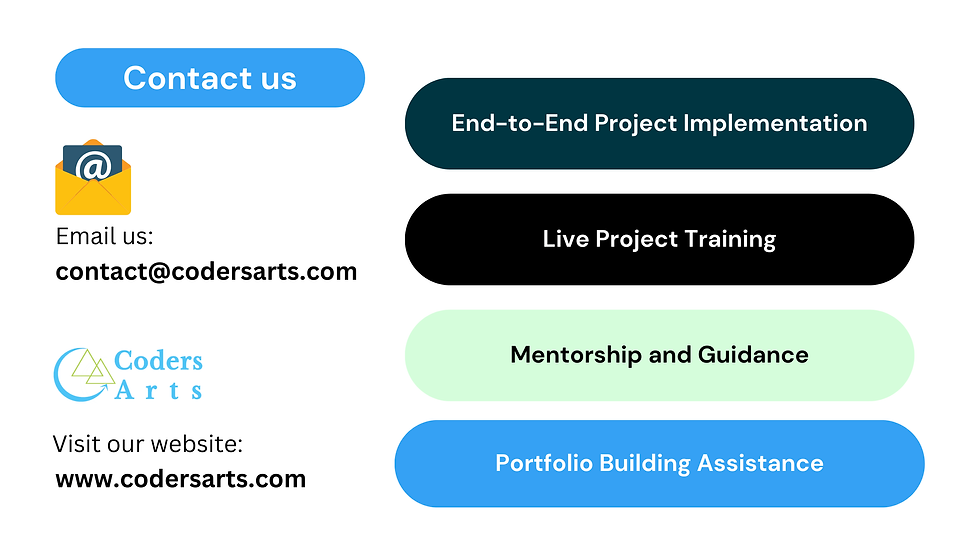Exploratory Data Analysis and Predictive Modeling for Customer Churn Analysis
- Codersarts

- Dec 9, 2024
- 4 min read
Struggling with your Exploratory Data Analysis and Predictive Modeling assignment? Our experts are here to help! Get guidance on feature engineering, model selection, and performance evaluation to achieve your academic and professional goals.

Subject: Data Science
Category: Assignment Help
Objective:
Conduct Exploratory Data Analysis (EDA) and build a predictive model for customer churn analysis using a telecom dataset.
Part 1: Exploratory Data Analysis (EDA)
1. Data Cleaning:
Handle Missing Values:
Identify columns with missing values using isnull() or info() methods.
Replace missing values with appropriate imputation techniques:
Mean/Median for numerical data.
Mode for categorical data.
Domain-specific default values or forward/backward filling for time-series data.
Check for Duplicates and Inconsistencies:
Remove duplicate records using drop_duplicates().
Standardize categorical values (e.g., convert "Yes"/"Y"/"y" into "Yes").
Format Data Types:
Ensure consistency in data types for numerical and categorical features.
Convert date columns into datetime format for proper analysis.
2. Data Visualization:
Feature Distributions:
Use histograms to analyze the distribution of continuous variables.
Use box plots to detect outliers and understand variance.
Relationship Analysis:
Use scatter plots to explore relationships between numerical features.
Create heatmaps and correlation matrices to identify highly correlated features.
Target Variable Exploration:
Analyze the distribution of the target variable (e.g., churn rates) using count plots.
Use visualizations to compare churn rates across demographic groups, contract types, or other categorical features.
3. Insights Derivation:
Summarize Findings:
Highlight features that appear significant in influencing the target variable (e.g., high churn rates for customers with monthly contracts).
Identify Patterns:
Look for trends, such as whether customers with higher tenure are less likely to churn.
Provide Actionable Insights:
Translate findings into recommendations (e.g., "Offer discounts to customers with monthly contracts to reduce churn rates").
Part 2: Feature Engineering
1. Feature Transformation:
Normalize/Standardize Numerical Features:
Scale features like MonthlyCharges and TotalCharges to ensure comparability across models.
Encode Categorical Features:
Use one-hot encoding for nominal variables like Contract (e.g., "Monthly", "Yearly").
Use label encoding for ordinal variables if applicable.
2. Feature Creation:
Derived Features:
Calculate average monthly charges by dividing TotalCharges by tenure.
Create a feature for "customer age" if the data includes a sign-up date.
Interaction Features:
Combine features like tenure and contract to represent long-term customers.
3. Feature Selection:
Use techniques like correlation analysis, variance thresholding, or feature importance (e.g., from Random Forest) to select the most significant features.
Part 3: Predictive Model Development
1. Model Selection:
Start with Logistic Regression as a baseline model for binary classification.
Use Random Forest for a robust, interpretable model that can capture feature importance.
2. Model Training:
Split the dataset into training and testing subsets (e.g., 80%-20%).
Train multiple models and compare their performance using cross-validation.
3. Hyperparameter Tuning:
Use GridSearchCV or RandomSearchCV to optimize model hyperparameters (e.g., number of trees in Random Forest).
4. Model Interpretation:
For Logistic Regression, analyze coefficients to understand feature impact.
For Random Forest, use feature importance scores for insights.
Part 4: Model Evaluation
1. Metrics Calculation:
Accuracy: Overall performance metric.
Precision: Focus on correctly identifying churned customers.
Recall: Measure of capturing all actual churned customers.
F1-Score: Balance between precision and recall.
ROC-AUC: Compare models’ performance using Receiver Operating Characteristic curves.
2. Cross-Validation:
Use k-fold cross-validation to ensure model robustness and avoid overfitting.
3. Insights from Evaluation:
Summarize findings, e.g., "Random Forest achieved the best F1-score of 0.85, indicating a good balance between precision and recall."
Highlight areas for improvement (e.g., "Additional features or data may further improve recall").
Part 5: Deliverables
EDA Report:
Summarize data cleaning, visualizations, and insights.
Feature Engineering Summary:
Highlight new features and their potential impact.
Predictive Model Code:
Provide well-commented Python code or Jupyter Notebook.
Model Evaluation Results:
Include metrics and final recommendations for improving churn rates.
This expanded format provides detailed guidance for each task and makes the assignment easy to follow.
Need Help with Your Data Science Assignment?
At Codersarts, we specialize in providing top-notch Data Science Assignment Help to students and professionals. Whether you're working on Exploratory Data Analysis, Predictive Modeling, or advanced machine learning tasks, our team of experienced data scientists and developers can guide you every step of the way.
Why Choose Codersarts?
Expert Guidance on EDA, Feature Engineering, and Predictive Modeling
Customized Code Implementation with Clear Explanations
Comprehensive Report Preparation and Insights Derivation
Timely Delivery to Meet Your Deadlines
One-on-One Mentorship and Support
At Codersarts, we provide comprehensive data science assignment services to meet your academic and professional needs. Whether you’re looking to buy data science assignment help, hire a data science tutor, or simply order data analysis help, our team of data analysis experts is here to assist. We cater to all levels, offering data science tutoringand affordable data science tutoring packages for students and professionals alike.
From data science project assistance and expert data science assignment solutions to purchase data science homework assistance, you can count on our specialists for timely, high-quality results. Turn to us for the best data science assignment help and get help with data science projects that will elevate your understanding and performance in the field.

Keywords: Buy data science assignment help, Hire data science tutor, Data science assignment services, Order data analysis help, Get help with data science projects, Purchase data science homework assistance, Expert data science assignment solutions, Data science tutoring, Data analysis experts, Data science project assistance, Best data science assignment help, Affordable data science tutoring



Comments